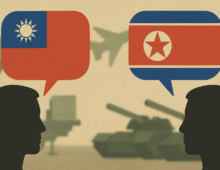AI could help Seoul quickly improve its intel and recon capabilities, but major technological limitations remain
The persistent nuclear and missile threat from North Korea continues to drive South Korea to modernize its military, and while the Yoon administration has largely stuck to Seoul’s long-standing approach, it has shown an increased willingness to explore new technologies to offset the DPRK’s rapid weapons advances.
Seoul’s comprehensive strategy for addressing the North Korean threat currently encompasses a four-pronged approach. Three of these prongs are well known as part of the three-axis system: the preemptive Kill Chain, the retaliatory Korea Massive Punishment and Retaliation (KMPR) plan and Korea Air and Missile Defense.
The persistent nuclear and missile threat from North Korea continues to drive South Korea to modernize its military, and while the Yoon administration has largely stuck to Seoul’s long-standing approach, it has shown an increased willingness to explore new technologies to offset the DPRK’s rapid weapons advances.
Seoul’s comprehensive strategy for addressing the North Korean threat currently encompasses a four-pronged approach. Three of these prongs are well known as part of the three-axis system: the preemptive Kill Chain, the retaliatory Korea Massive Punishment and Retaliation (KMPR) plan and Korea Air and Missile Defense.
Get your
KoreaPro
subscription today!
Unlock article access by becoming a KOREA PRO member today!
Unlock your access
to all our features.
Standard Annual plan includes:
-
Receive full archive access, full suite of newsletter products
-
Month in Review via email and the KOREA PRO website
-
Exclusive invites and priority access to member events
-
One year of access to NK News and NK News podcast
There are three plans available:
Lite, Standard and
Premium.
Explore which would be
the best one for you.
Explore membership options
© Korea Risk Group. All rights reserved.
No part of this content may be reproduced, distributed, or used for
commercial purposes without prior written permission from Korea Risk
Group.












